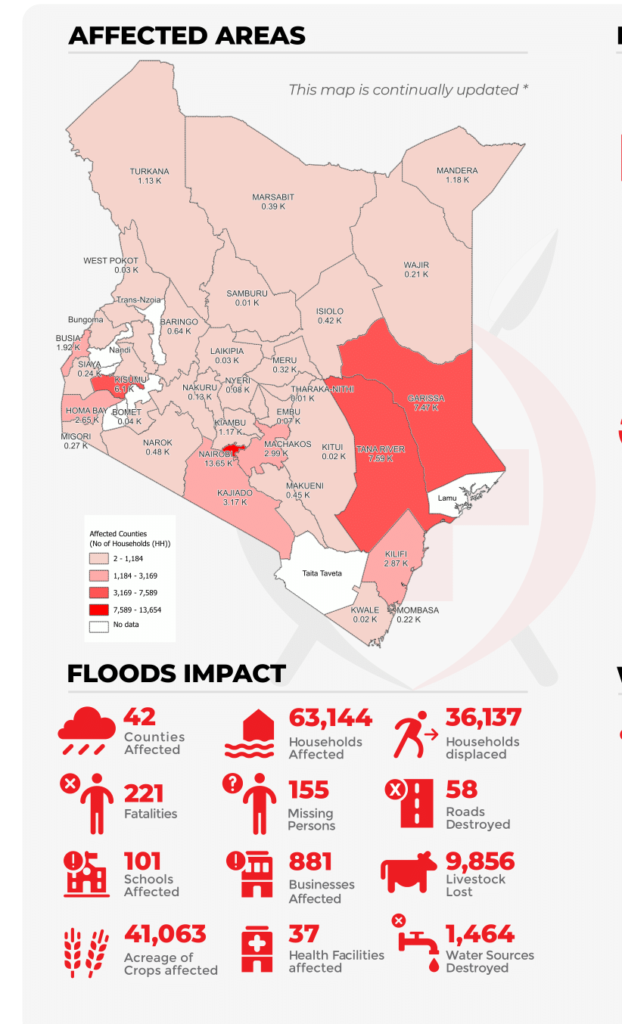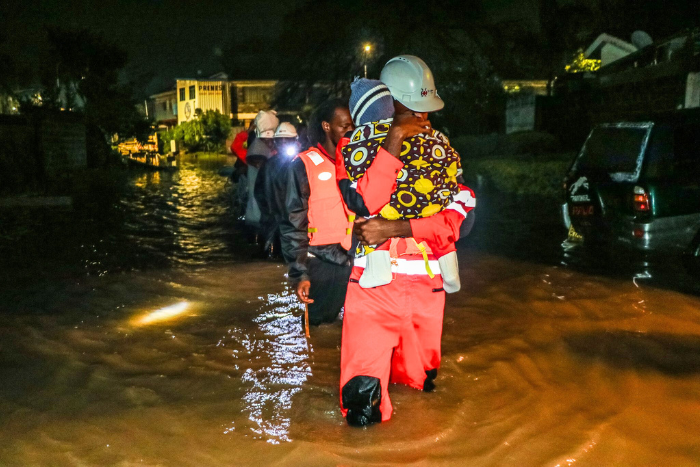Natural phenomena such as El Niño and the Indian Ocean Dipole found to have very little to do with the current extreme weather in the region, according to data
More than 200 people have been killed and more than 150,000 have been displaced in Kenya due to extreme rainfall and consequent flooding. On April 29, a dam in Nakuru County burst due to excessive precipitation, killing at least 50 people—seventeen of them were children. Across the nation, businesses and schools are still closed due to the closure of major roadways. While threats from tropical cyclone Hidaya were rising and were expected to make the matters worse, the cyclone weakened after making landfall on Saturday. Kenya and neighbouring Tanzania managed to avoid significant damage.

“Over the past few weeks we have been conducting rescue and operations efforts to families affected by the ongoing floods in Kenya. We need to look at longer term solutions around resilience to avoid the losses and damages we are currently experiencing. The costs of the flood impacts are yet again an awakening call that our communities need to be supported to be resilient and adapt to curb such disasters in future,” said Venant Ndighila, head of disaster operations, Kenya Red Cross Society.
Climate change at play?
Situated in East Africa, Kenya—like the rest of the region—has a unique climate. Although located in the wet equatorial belt, the region experiences both very dry conditions and heavy rainfall episodes. Temperatures are also milder than in other tropical regions due to its relatively high elevation.
East Africa is also one of the most vulnerable regions to extreme weather events associated with climate change. Like in many other parts of the world, climate change has led to increasing frequency and intensity of extreme precipitation and flooding across Africa. The Intergovernmental Panel on Climate Change (IPCC) report noted that climate change is projected to increase the frequency and intensity of heavy precipitation and flooding with additional global warming in East Africa. Under a 1.5oC increase in global temperature, mean annual rainfall is projected to increase.
Normally, rain usually falls during two different periods in East Africa. The long rainfall season lasts from March to May and the short season runs from October to December. The shorter period not only brings less rain, but is also more variable year to year compared to the longer period, which is more consistent.
Reports have found an increase in the number of heavy rainfall days in Kenya, which can be partly explained by climate change. Also, a recent attribution study showed that floods that happened in a similar region in the last months of 2023 were made twice more intense by climate change.
Data shows role of natural phenomena to be minimal
Natural phenomena such as the El Niño-Southern Oscillation (ENSO) and the Indian Ocean Dipole (IOD) affect the rainfall pattern in East Africa. Regarding ENSO, El Niño is currently weakening and approaching a neutral state, while IOD is currently neutral.
ENSO doesn’t seem to affect the long rains, between March and May as shown by research. The short rains are strongly influenced by the ENSO. It is a natural climate pattern that alternates between three phases: El Niño, La Niña and neutral. During El Niño years, the short rains, those happening between October and December, are more intense.
The IOD is a climate pattern where the temperature of the ocean water varies between the eastern and western parts of the Indian Ocean. IOD has three phases: positive, negative and neutral. A positive phase leads to more rain in East Africa, while a negative phase brings the opposite effect, with no major changes during the neutral phase.
The Madden-Julian Oscillation (MJO) influences both long and short rains on a monthly basis. This influence is the strongest in November, December, March and May, but it only explains around 20% of rainfall variations. The Quasi-Biennial Oscillation (QBO) interacts with MJO to influence rainfall, but predominantly between September and November. QBO explains less than 20% of rainfall.
With these phenomena contributing only a little to the current situation in Kenya, experts are calling climate change the accelerating factor.
“It is sobering to realise just how vulnerable our country is despite Kenya being one of the most economically developed in Africa. It shows that economic development alone is no match for the power of the climate emergency. We need much faster action to end the use of coal, oil and gas which are fuelling this extreme weather. The rich world has burned fossil fuels which caused this destruction but have failed to take responsibility for their actions. It is an outrage and the Global South should demand much more climate finance at this year’s COP29 climate summit in Baku, Azerbaijan,” said Mohamed Adow, director, Power Shift Africa.
About The Author
You may also like
Fog grips North India as cold wave spreads across central and southern states
Rains Lash South India as Early Cold Wave Grips Central and Northern India
India launches National Red List Assessment to map extinction risks of 11,000 species
Investing in solar, storage can save Thailand close to $2 billion: Report
At least 10 dead in heavy rain in Maharashtra, Mumbai crosses 3000 mm threshold

